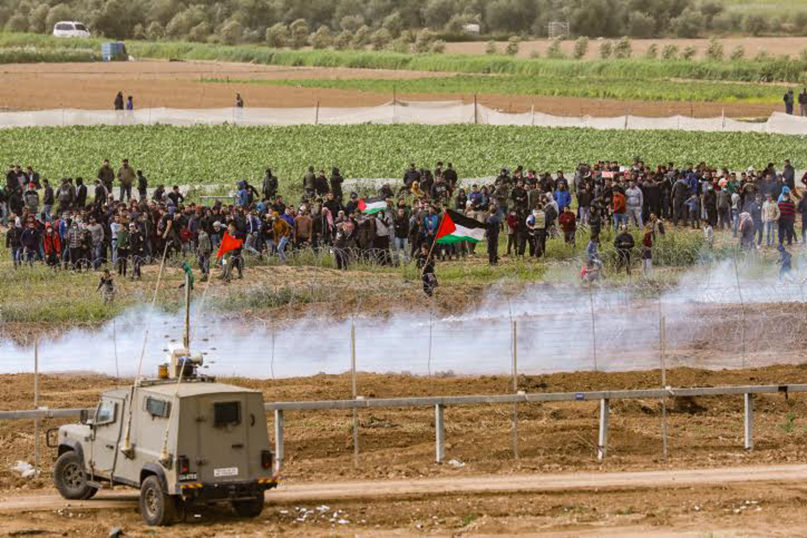
By Yaakov Lappin
(JNS) Few events better illustrate the need for the Israel Defense Forces’ policy of zero-tolerance to attempted Palestinian intrusions from Gaza than the capture earlier this month of two armed men near Kibbutz Erez, located just north of the Gaza Strip.
On March 8, IDF soldiers responding to a border intrusion alert from Gaza caught the two suspects, who were armed with grenades and knives. They were just a few minutes away were from Kibbutz Erez, where children play soccer in the fields.
The armed suspects turned out to be operatives affiliated to the Iranian-backed Palestinian Islamic Jihad terror faction, which has amassed a rocket arsenal in Gaza that is even bigger than that of Hamas. Collectively, the Gazan rocket arsenal surpasses 20,000 projectiles.
The armed intruders arrived on a Friday, when Hamas organizes weekly mass border riots. During these events, Hamas sends thousands of people towards the border with Israel. Small teams of armed terrorists then try to use the civilian rioters as human shields, approaching the border fence to attempt intrusions.
On Saturday, during “Land Day,” Hamas organized some 40,000 Palestinians and sent them to the border, but this time, it made a bigger effort than usual to prevent many of them from approaching the fence. The reason for this uncharacteristic caution: Hamas is waiting to see whether Israel accepts some of its demands. This caution has not extended to rocket strikes on southern Israel, which continues into civilian areas.
For the past year, Hamas has employed weekly protests called the “March of Return” as an extortion technique to pressure Israel into allowing more funds and infrastructure projects into Gaza. Israel, for its part, wants to assist Gazan civilians, who are essentially being held hostage by their regime, but is also keen to avoid a situation in which Hamas exploits any new agreement to build up its military wing, rocket arsenal and tunnel network.
Already, the factions in Gaza are better armed than they were in 2014 and have an array of domestic weapons’ production sites. Iran pays for this arms build-up and shares know-how in the manufacturing of rockets.
Yet Hamas remains deterred by the idea of an all-out war with Israel and instead seeks a way to save Gaza from implosion—to save its regime from a popular revolt and to do this without going to war. It has found the halfway tactic of “controlled escalations” to do this.
A year ago, Hamas quickly seized on the idea of “return marches.” It was keen to take control of a movement that otherwise could have turned into a threat against its own rule and use it to extort Israel.
Hamas’s total control of these weekly protests is unmissable and comes in the form of grenade attacks, IED border attacks and the cynical use of minors to plant bombs on the border fence.
Using children as a military tool is just one of many of Hamas’s tricks. The Gazan regime also sends women to roll tires to the border fence, and then sends children to set them on fire, creating a smokescreen designed to allow Gazan youths to approach the border fence and cut it open.
Hamas has instructed rioters to rush through such openings in the border fence, so it can inject small groups of operatives armed with grenades, knives and handguns. Their mission: head to nearby Israeli villages, located just a few hundred meters from the border.
Within three minutes, these terror squads can be at the entrances of Israeli villages. Some 60,000 Israelis live in the vicinity of the Gaza Strip, where they engage in agriculture and live out their lives, as the IDF works day and night to defend their safety.
Instead of working together with Gazans on joint agricultural initiatives, southern Israelis must face rockets, mortars, tunnels, arson, and balloons and kites that carry explosive devices over the border, which the IDF rushes to neutralize before children pick them up.
Hamas has not gotten away with this “controlled” aggression without paying a price. In the past 12 months, the Israeli Air Force struck hundreds of Hamas targets in Gaza, destroying a portion of the military wing’s infrastructure, rocket depots, bases, headquarters and military posts. Hamas has accumulated a large proportion of damage that will cost it dearly to rebuild.
None of these events have so far changed Hamas’s basic problems: It risks losing control of Gaza, as civilians find the courage to publicly condemn its failings and have started protesting the low quality of living. Hamas makes half a billion dollars a year just from taxes it imposes on goods entering Gaza from Egypt, but most of that money goes to the military wing, not to Gaza’s people. Likewise, Iran’s annual assistance package goes to the military wings of Hamas and PIJ.
Hamas may be well-armed, but it remains isolated, exposed to Egyptian pressure, and it is in a state of unending conflict with its chief internal rival, Fatah.
Its rule in Gaza is also tested by the other armed factions, chief among them, Palestinian Islamic Jihad, which can “employ” the Israeli Air Force to strike Hamas by launching rockets on their own initiative.
Unclear how long Hamas can rely on current tactics
The less stable situation for Hamas, the more it will seek to divert aggression outwards—in Israel’s direction—and the chances for armed conflict will increase.
Hamas’s answer to this paradox is to sacrifice the Gazan population and rally them under its flag by inciting them against the old familiar enemy of Israel.
It remains unclear how much longer Hamas will be able to rely on this tactic. Palestinian Authority leader Mahmoud Abbas has cut the budget for Gaza by around 30 percent. Egypt is working hard to stabilize the situation, but the Egyptians are not exactly fans of the concept of a Muslim Brotherhood regime holding power on their border.
Israel is systematically destroying Hamas’s cross-border tunnels, in which Hamas has invested huge resources, like cement, into building, instead of investing in housing for Gazans.
And Hamas continues to fire rockets indiscriminately into Israeli civilian areas with the intention of killing. Israel, for its part, carefully picks out every enemy target, looking to reduce collateral damage to the absolute minimum.
The central question now is how much longer this situation can continue. The two main scenarios appear to be either a broader Israeli military campaign in response to a new Hamas escalation or a long-term truce that will see Gaza receive large-scale international funds and infrastructure development programs, thereby saving the Hamas regime.
Israel sees an improvement of the humanitarian situation in Gaza as its own security interest, but only if this occurs without strengthening Hamas’s military and terrorism capabilities. So far, the formula for doing that has been elusive.
In the meantime, Hamas’s unending terrorism against Israelis and war of attrition on the western Negev continues. Its only achievement so far has been to put Gaza back at the top of the agenda in Israel and in the international community. The Gazan time bomb continues to tick.
As the region waits to see whether diplomacy succeeds, the IDF stands ready at the Gazan border with four brigades, a large build-up of armored vehicles and infantry, and an air force that is on high alert.
In today’ Middle East, war can erupt even when neither side desires it, with the smallest incident or miscalculation snowballing into an armed conflict.
Israel, however, is far stronger than Hamas, and should a new conflict erupt, the regime will pay a very heavy price.
CAP: Israeli security forces clash with Palestinian protesters as it seen from the Israeli side of the border with the Gaza Strip on March 30, 2019. Palestinian continue to demonstrate by the border to mark Land Day. Credit: Noam Revkin Fenton/Flash90








 Southern New England Jewish Ledger
Southern New England Jewish Ledger














